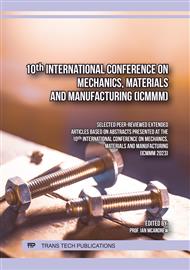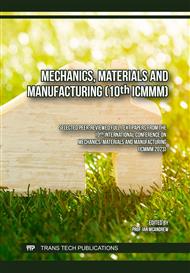[1]
V.S. Athira, V. Charitha, G. Athira, and A. Bahurudeen: Agro-waste ash based alkali-activated binder: Cleaner production of zero cement concrete for construction, J. Clean. Prod. Vol. 286 (2021), p.125429.
DOI: 10.1016/j.jclepro.2020.125429
Google Scholar
[2]
J. Davidovits: Global warming impact on the cement and aggregates industries, World Resour. Rev. Vol. 6 (1994), p.263–278.
Google Scholar
[3]
V. Masson-Delmotte, P. Zhai, H.-O. Pörtner, D. Roberts, J. Skea, P.R. Shukla, A. Pirani, W. Moufouma-Okia: Global warming of 1.5 C̊, An IPCC Spec. Rep. Impacts Glob. Warm. Vol. 1 (2018), p.36. https://www.ipcc.ch/sr15/.
Google Scholar
[4]
T. Bakharev, J.G. Sanjayan, and Y.-B. Cheng: Sulfate attack on alkali-activated slag concrete, Cem. Concr. Res. Vol. 32 (2002), p.211–216. https://doi.org/.
DOI: 10.1016/S0008-8846(01)00659-7
Google Scholar
[5]
R.J. Thomas, H. Ye, A. Radlinska, and S. Peethamparan: Alkali-activated slag cement concrete, Concr. Int. Vol. 38 (2016), p.33–38.
Google Scholar
[6]
A. Bisarya, R.K. Chouhan, M. Mudgal, and S.S. Amritphale: Fly ash based geopolymer concrete a new technology towards the greener environment: A review, Int. J. Innov. Res. Sci. Eng. Technol. Vol. 4 (2015), p.12178–12186. https://doi.org/10.15680/IJIRSET. 2015.0412089.
Google Scholar
[7]
M.I.A. Aleem, and P.D. Arumairaj: Geopolymer concrete–a review, Int. J. Eng. Sci. Emerg. Technol. Vol. 1 (2012), p.118–122.
DOI: 10.7323/ijeset/v1_i2_14
Google Scholar
[8]
F. Ameri, S.A. Zareei, and B. Behforouz: Zero-cement vs. cementitious mortars: An experimental comparative study on engineering and environmental properties, J. Build. Eng. Vol. 32 (2020), p.101620.
DOI: 10.1016/j.jobe.2020.101620
Google Scholar
[9]
R. Arellano Aguilar, O. Burciaga Díaz, and J.I. Escalante García: Lightweight concretes of activated metakaolin-fly ash binders, with blast furnace slag aggregates, Constr. Build. Mater. Vol. 24 (2010), p.1166–1175.
DOI: 10.1016/j.conbuildmat.2009.12.024
Google Scholar
[10]
S.E.W.D.M.J.S. Djwantoro Hardjito, and B.V. Rangan: On the Development of Fly Ash-Based Geopolymer Concrete, ACI Mater. J. Vol. 101 (2004), p.6.
DOI: 10.14359/13485
Google Scholar
[11]
P. Shoaei, F. Ameri, H. Reza Musaeei, T. Ghasemi, and C.B. Cheah: Glass powder as a partial precursor in Portland cement and alkali-activated slag mortar: A comprehensive comparative study, Constr. Build. Mater. Vol. 251 (2020), p.118991.
DOI: 10.1016/j.conbuildmat.2020.118991
Google Scholar
[12]
N.A. Lloyd, and B. V Rangan: Geopolymer concrete with fly ash, Proc. Second Int. Conf. Sustain. Constr. Mater. Technol. Vol. 3 (2010), p.1493–1504. https://espace.curtin.edu.au/handle/20.500.11937/3540.
Google Scholar
[13]
IS-10262: Recommended Guidelines for Concrete Mix Proportioning, (2009).
Google Scholar
[14]
R. Anuradha, V. Sreevidya, R. Venkatasubramani, and B.Vv. Rangan: Modified guidelines for geopolymer concrete mix design using Indian standard, ASIAN J. Civ. Eng. (BUILDING HOUSING). Vol. 13 (2012), p.357–368. https://www.sid.ir/en/Journal/ViewPaper. aspx?ID=247118.
Google Scholar
[15]
M. Ferdous, O. Kayali, and A. Khennane: A detailed procedure of mix design for fly ash based geopolymer concrete, in: Fourth Asia-Pacific Conference on FRP in Structures (APFIS 2013).
Google Scholar
[16]
P. Pavithra, M. Srinivasula Reddy, P. Dinakar, B. Hanumantha Rao, B.K. Satpathy, and A.N. Mohanty: A mix design procedure for geopolymer concrete with fly ash, J. Clean. Prod. Vol. 133 (2016), p.117–125.
DOI: 10.1016/j.jclepro.2016.05.041
Google Scholar
[17]
T. Phoo-ngernkham, C. Phiangphimai, N. Damrongwiriyanupap, S. Hanjitsuwan, J. Thumrongvut, and P. Chindaprasirt: A Mix Design Procedure for Alkali-Activated High-Calcium Fly Ash Concrete Cured at Ambient Temperature, Adv. Mater. Sci. Eng. Vol. 2018 (2018), p.2460403.
DOI: 10.1155/2018/2460403
Google Scholar
[18]
P. Dinakar, K.P. Sethy, and U.C. Sahoo: Design of self-compacting concrete with ground granulated blast furnace slag, Mater. Des. Vol. 43 (2013), p.161–169.
DOI: 10.1016/j.matdes.2012.06.049
Google Scholar
[19]
N. Li, C. Shi, Z. Zhang, H. Wang, and Y. Liu: A review on mixture design methods for geopolymer concrete, Compos. Part B Eng. Vol. 178 (2019) p.107490. https://doi.org/.
DOI: 10.1016/j.compositesb.2019.107490
Google Scholar
[20]
E. Gomaa, S. Sargon, C. Kashosi, and M. ElGawady: Characterization and Performance of Zero-Cement Concrete, United States, Missouri, (2018). https://rosap.ntl.bts.gov/view/dot/37913.
Google Scholar
[21]
BS-1881-116: Method for Determination of Compressive Strength of Concrete Cubes, London, in: Br. Stand. Inst., (1881).
Google Scholar
[22]
K.H. Younis, K. Salihi, A. Mohammedameen, A.F.H. Sherwani, and R. Alzeebaree: Factors affecting the Characteristics of Self-Compacting Geopolymer Concrete, IOP Conf. Ser. Earth Environ. Sci. Vol. 856 (2021), p.12028.
DOI: 10.1088/1755-1315/856/1/012028
Google Scholar



